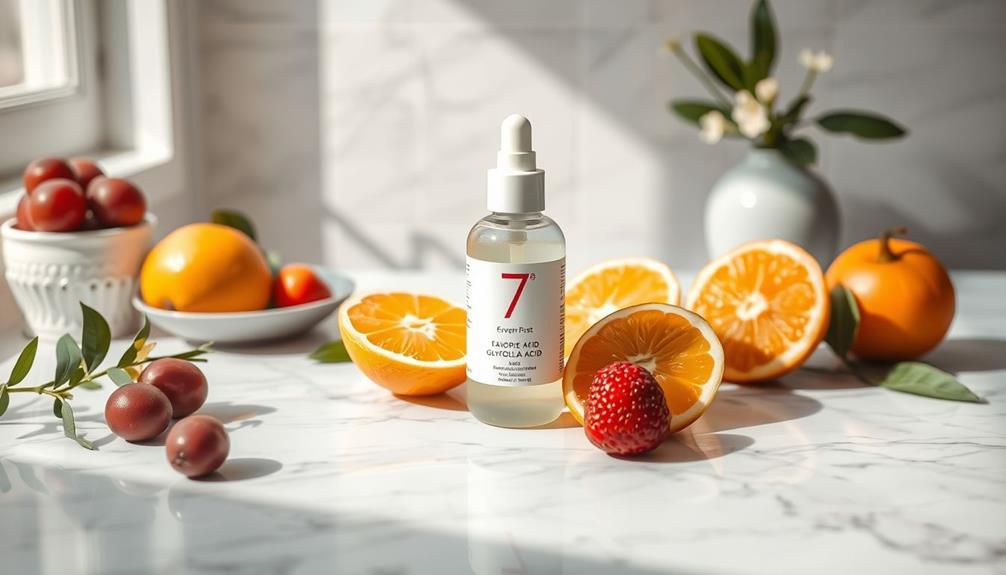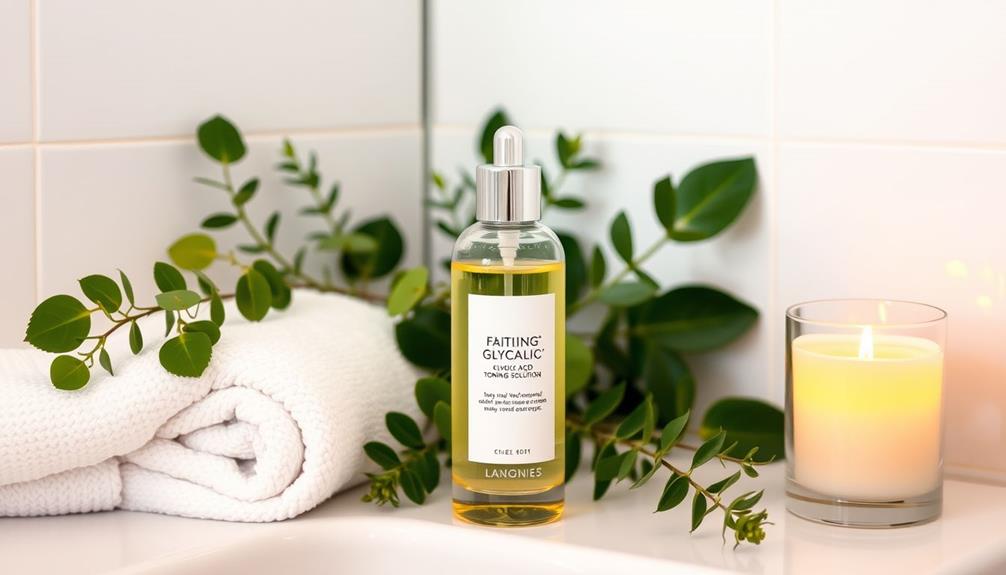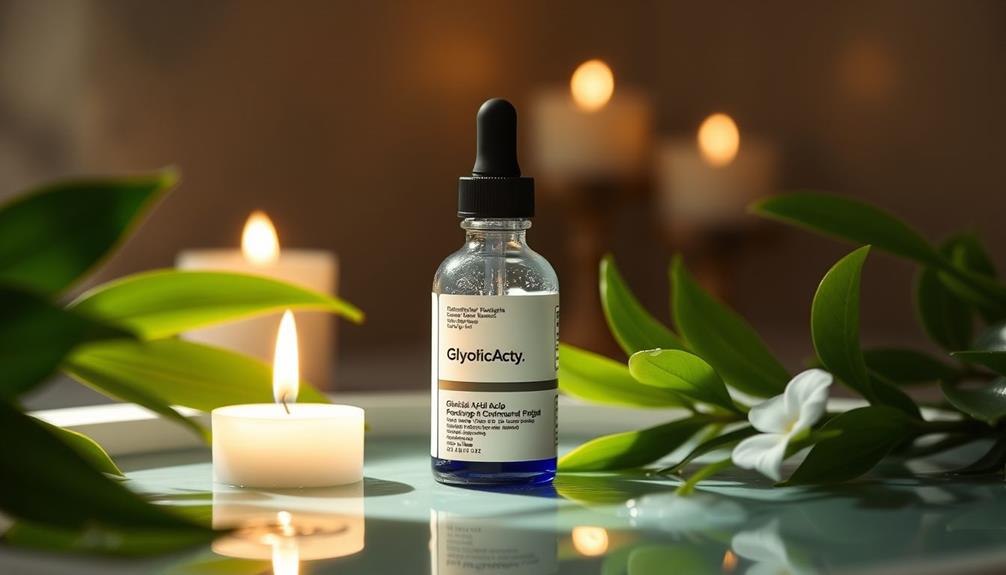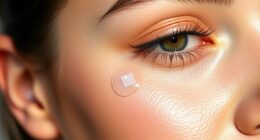Glycolic acid's small molecular size allows it to penetrate deeply into your skin, making it an effective acne treatment. It gently exfoliates dead skin cells, unclogs pores, and reduces oiliness, all while soothing inflammation for calmer skin. By promoting faster cell turnover and stimulating collagen production, it enhances overall skin texture. Regular use can greatly decrease both inflammatory and non-inflammatory acne lesions. For the best results, start with lower concentrations and gradually increase usage. With proper incorporation into your routine, you can achieve clearer, smoother skin. There's much more to uncover about its benefits and applications!
Key Takeaways
- Glycolic acid promotes chemical exfoliation, removing dead skin cells and preventing clogged pores that lead to acne breakouts.
- Its anti-inflammatory properties soothe irritated skin, reducing redness and improving overall acne severity.
- By increasing cell turnover, glycolic acid helps minimize dead skin buildup, allowing for clearer skin.
- It decreases sebum production, which lowers the chances of acne formation and helps regulate oily skin.
Understanding Glycolic Acid

Have you ever wondered why glycolic acid is so effective for acne treatment? This alpha hydroxy acid (AHA), derived from sugar cane, stands out due to its small molecular size, allowing it to penetrate the skin deeply.
Glycolic acid promotes chemical exfoliation by dissolving the bonds between dead skin cells, which helps to shed them more easily. This process not only reduces acne lesions but also improves skin texture considerably.
Additionally, incorporating essential oils for skin health can further enhance your skincare routine, providing natural benefits alongside glycolic acid.
When you incorporate glycolic acid into your skincare routine, you can expect a smoother, clearer complexion.
Clinical studies reveal that regular use can lead to significant decreases in both inflammatory and non-inflammatory acne. Furthermore, glycolic acid stimulates collagen production, enhancing your skin's overall appearance and helping to combat signs of aging.
You'll find glycolic acid in various skincare products and professional treatments, such as chemical peels, making it a favorite among dermatologists.
If you're looking for an effective acne treatment that also improves your skin's texture, glycolic acid could be the solution you need.
Embracing this powerful ingredient might just transform your skincare routine for the better.
How Glycolic Acid Works

Glycolic acid works by gently exfoliating dead skin cells, helping you achieve a smoother complexion.
It effectively reduces inflammation, which can lessen the severity of breakouts.
Additionally, incorporating essential oils for specific conditions can further enhance skin health and promote healing.
With consistent use, you'll notice an improvement in your skin's texture and overall radiance.
Exfoliation and Dead Skin
Exfoliating with glycolic acid effectively breaks down the bonds between dead skin cells, making it easier for your skin to shed them and reveal a smoother texture. As an alpha hydroxy acid (AHA), glycolic acid penetrates deeply, enhancing exfoliation while promoting cell turnover. This process is essential for clearing clogged pores, which often lead to acne breakouts.
Here's a quick overview of how glycolic acid benefits your skin:
| Benefit | Description |
|---|---|
| Exfoliation | Removes dead skin cells, enhancing skin texture. |
| Clogged Pores | Clears impurities, reducing the chances of acne. |
| Cell Turnover | Promotes faster regeneration of skin cells. |
| Sebum Production | Decreases oiliness, which helps prevent breakouts. |
| Overall Skin Appearance | Improves skin tone and texture for a radiant look. |
Regular use of glycolic acid not only tackles existing acne but also prevents future breakouts by reducing sebum production. By incorporating this powerhouse ingredient into your skincare routine, you're taking a significant step towards clearer, healthier skin.
Reducing Inflammation Effectively
While enhancing exfoliation helps with acne prevention, reducing inflammation is equally important for achieving clearer skin.
Glycolic acid plays a vital role in this process through its powerful exfoliating properties. By promoting cell turnover, it aids in the healing of acne lesions and greatly improves overall skin texture.
Additionally, incorporating eye patches as part of your skincare routine can also help in reducing puffiness and dark circles, complementing the benefits of glycolic acid.
Clinical studies show that glycolic acid peels effectively reduce both inflammatory and non-inflammatory acne breakouts over time.
When you incorporate glycolic acid into your skincare routine, you're not just sloughing off dead skin cells; you're also unclogging pores, which minimizes the likelihood of inflammation-related flare-ups.
Regular use can lead to decreased sebum production, further helping to alleviate acne-related inflammation.
Dermatologists often recommend glycolic acid as an effective adjunctive treatment for acne vulgaris due to its ability to soothe inflamed skin, ultimately promoting a clearer complexion.
Enhancing Skin Texture
As the smallest alpha hydroxy acid, glycolic acid penetrates the skin effectively, promoting the shedding of dead skin cells and enhancing overall skin texture. Its powerful exfoliating properties help to unclog pores, greatly reducing acne lesions and preventing future breakouts. By regularly incorporating glycolic acid into your routine, you're not just targeting existing flaws; you're actively improving skin texture over time.
Incorporating gentle yoga stretches can also support skin health by promoting circulation and relaxation, which can be beneficial for overall skin appearance.
Glycolic acid stimulates collagen production, which is essential for a youthful appearance. Studies show that consistent use can thicken the skin by increasing epidermal thickness by up to 27% in just six months. This thickening contributes to a more resilient skin texture that withstands environmental stressors better.
Moreover, glycolic acid enhances the absorption of other skincare products, maximizing their effectiveness. When you use it, you're not only treating your skin but also preparing it for better product penetration.
Whether through serums or chemical peels, the benefits of glycolic acid extend beyond mere exfoliation. You'll notice smoother, clearer, and more radiant skin as it works to promote cell turnover and refine your skin texture.
Benefits for Acne-Prone Skin

If you're dealing with acne-prone skin, glycolic acid offers some significant benefits.
It effectively exfoliates, unclogs pores, and helps reduce inflammation and redness.
Exfoliation and Pore Unclogging
Glycolic acid offers powerful exfoliation benefits that effectively unclog pores and prevent acne breakouts. As an alpha hydroxy acid, it gently exfoliates by dissolving the bonds between dead skin cells, promoting their shedding. This is essential for acne-prone skin, as it helps reduce clogged pores that often lead to breakouts.
By increasing cell turnover, glycolic acid minimizes the buildup of dead skin cells that trap oil and bacteria, common culprits in acne development. Furthermore, glycolic acid decreases sebum production, lowering the chances of clogged pores and, ultimately, acne formation. Regular use can lead to a significant improvement in skin texture, making your complexion smoother and healthier.
Additionally, the exfoliating properties of glycolic acid enhance the effectiveness of other acne treatments you may be using. With improved absorption of topical products, you'll likely see better results from your skincare routine. Incorporating glycolic acid into your regimen can be a game-changer for combatting acne, ensuring that your skin stays clear and radiant.
Embrace the power of glycolic acid and watch your skin transform!
Reducing Inflammation and Redness
Reducing inflammation and redness is another considerable benefit of glycolic acid for acne-prone skin, enhancing both comfort and appearance. By incorporating glycolic acid into your skincare routine, you can experience several key advantages:
- Decreased Redness: Glycolic acid helps to soothe irritated skin, leading to a noticeable reduction in redness associated with acne lesions.
- Improved Acne Severity: Regular use can considerably improve acne severity, reducing both inflammatory and non-inflammatory lesions.
- Enhanced Cell Turnover: Its exfoliating properties promote cell turnover, helping your skin shed dead cells and revealing healthier skin underneath.
- Reduced Sebum Production: Glycolic acid can lower sebum production, further contributing to reducing inflammation and preventing future breakouts.
With its ability to unclog pores and calm inflamed skin, glycolic acid is a powerful ally for anyone struggling with acne-prone skin. By addressing both the causes and symptoms of acne, you'll not only feel more comfortable but also enjoy a clearer, healthier complexion.
Embrace the benefits of glycolic acid and watch your skin transform!
Dermatologist Recommendations

When seeking effective acne treatment, dermatologists often recommend incorporating glycolic acid into your skincare routine for its proven exfoliating and anti-inflammatory benefits. This powerful ingredient helps exfoliate dead skin cells, unclogs pores, and reduces inflammation, making it ideal for managing acne. Dr. Bottiglione emphasizes that glycolic acid promotes cell turnover, leading to improvements in acne severity and overall skin texture.
To effectively use glycolic acid, consider the following dermatologist recommendations:
| Step | Recommendation | Purpose |
|---|---|---|
| Cleanse | Use a gentle cleanser before applying glycolic acid. | Prepares skin for better absorption. |
| Apply Glycolic Acid | Incorporate it 2-3 times a week, gradually increasing use. | Exfoliates dead skin cells. |
| Moisturize & Protect | Always follow with a moisturizer and sun protection. | Maintains hydration and protects skin. |
Clinical Evidence and Studies

Numerous clinical studies support the effectiveness of glycolic acid in treating acne, highlighting its ability to considerably reduce both inflammatory and non-inflammatory lesions. Research consistently demonstrates that glycolic acid is a valuable tool in effective acne management. Here are some key findings:
- Reduction in Acne Lesions: Clinical studies show significant decreases in both inflammatory and non-inflammatory acne lesions with regular glycolic acid use.
- Skin Texture Improvement: Research published in the Journal of the American Academy of Dermatology indicates that glycolic acid peels lead to improved skin texture and fewer acne lesions.
- Sebum Production: Studies link glycolic acid's ability to decrease sebum production with its effectiveness in reducing acne severity.
- Adjunctive Therapy: One study reveals that glycolic acid can act as an adjunctive therapy for acne vulgaris, highlighting its role in enhancing overall treatment outcomes.
These findings emphasize glycolic acid's efficacy in tackling acne and improving skin texture.
If you're looking for a solution to manage your acne, evaluate the clinical evidence supporting glycolic acid's benefits for clearer skin.
Incorporating Into Your Routine

To effectively incorporate glycolic acid into your skincare routine, start with low concentrations and gradually increase usage to build tolerance.
Begin with products containing 5-10% glycolic acid, applying them once or twice a week. This approach minimizes skin sensitivity and allows your skin to adjust without excessive irritation.
It's best to apply glycolic acid at night. This timing not only reduces the risk of sun sensitivity but also enhances its effectiveness by promoting skin cell turnover while you sleep.
After applying glycolic acid, follow up with a moisturizer to hydrate your skin and protect your skin barrier from potential dryness.
As your skin adapts, you can gradually increase the frequency of use. Just remember to monitor how your skin reacts and adjust accordingly.
Also, don't skip sun protection during the day. Glycolic acid can make your skin more sensitive to UV rays, so wearing broad-spectrum sunscreen is essential for maintaining healthy skin.
Precautions and Best Practices

Taking precautions is essential when using glycolic acid to prevent irritation and guarantee the best results for your skin. Here are some best practices to follow:
- Start Slowly: Begin with low concentrations of glycolic acid (5-10%) to minimize the risk of irritation, especially if you have sensitive skin.
- Patch Test: Always conduct a patch test on a small area of skin before full application. This helps you monitor for any adverse reactions.
- Gradual Incorporation: Slowly introduce glycolic acid into your skincare regimen, limiting usage to once or twice a week initially. This allows your skin to adjust without overwhelming it.
- Use Sunscreen: After applying glycolic acid, follow up with a broad-spectrum sunscreen (SPF 30+) to protect the newly exposed skin and reduce increased UV sensitivity.
If you notice irritation in some people or experience persistent discomfort, consult a dermatologist for personalized advice.
Recommended Glycolic Acid Products

Finding the right glycolic acid products can enhance your acne treatment routine and help you achieve clearer skin.
Dermatologists recommend starting with lower concentrations, around 5-10%, to minimize irritation while still benefiting from the exfoliating effects. This approach allows your skin to adjust and gradually reap the rewards of improved skin texture.
Two highly recommended glycolic acid products are Caudalie Vinoperfect and Pixi Glow Tonic. Both of these options are known for their exfoliating and skin-brightening properties, making them effective choices for treating acne. Regular use of these products can greatly improve acne severity and overall skin health.
If you're looking to make your introduction to glycolic acid more affordable, keep an eye out for special promotions, like 10% off first orders from select brands.
Incorporating these products into your routine can lead to noticeable results, so don't hesitate to give them a try. By selecting the right glycolic acid products and using them consistently, you'll be on your way to achieving the clear, radiant skin you desire.
Conclusion
In the battle against acne, glycolic acid emerges as a powerful ally.
By gently exfoliating and unclogging pores, it reveals your skin's true potential.
Why settle for anything less than clear, radiant skin?
With the right products and a thoughtful routine, you can harness its benefits and regain your confidence.
So, take the leap—embrace glycolic acid and watch your skin transform into the canvas you've always wanted it to be!










